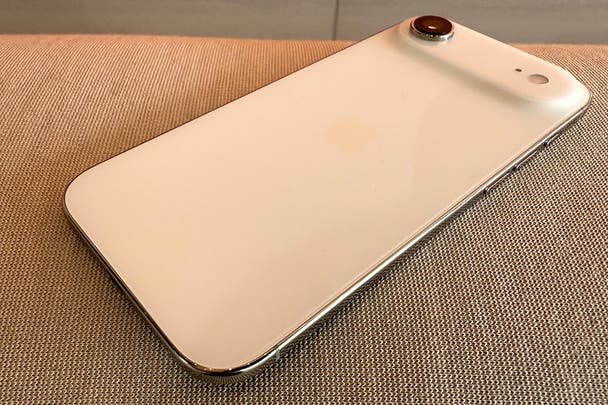iPhone Air: Design and display
The iPhone Air looks enticingly slim but it’s when you pick it up that it becomes apparent just how thin and light it is. In fact, jaws may drop when you consider something with such a big screen (6.5in, which used to be the size of a Pro Max iPhone a few years ago) can be so light. My first reaction was to ask if something had been left out, but it seems to be complete.
You can roll the iPhone in your hand like a worry stone, something the iPhone 17 Pro Max is just too big for, whoever you are. In general use, it feels great in the hand and it plays into something Apple’s Craig Federighi talked about when the iPhone X was launched – how it was a step closer to a device that vanishes, leaving nothing between you and the content. Having a phone this light takes you closer still to that ideal.
Of course, the camera bump is quite pronounced, and, unlike previous years’ iPhones, stretches the width of the phone. That’s also the case for the iPhone 17 Pro and Pro Max. Here, it’s so most of the electronic components have a place to live, enabling the rest of the body to be almost entirely taken up with battery.
That leads us to the eSIM. You can switch from a physical SIM to an eSIM on any current iPhone, but to maximise battery space, Apple didn’t put a SIM card tray into this device.
Switching to eSIM may sound daunting but Apple and most UK carriers have made it a simple process. When you’re buying the iPhone Air, the carrier can activate your eSIM immediately. If that’s not available, then eSIM quick transfer means you put your old and new iPhones together and it converts your physical SIM to eSIM.
Though the iPhone Air is as thin as it is, I’ve found no suggestion that it will bend. Try and flex it and it feels solid, with no creaking or movement.
Similarly, the new Ceramic Shield 2, which is the glass-like material on the back of the phone, has so far protected it from dings and scratches. Overall, it feels durable and strong.

Like every new iPhone just released, this one has Apple’s ProMotion display technology, meaning it has a dynamic refresh rate that ensures all content looks smooth, even when it’s moving fast, but saves battery when you’re looking at something still.
It’s an OLED screen, like the entire range (even the low-priced iPhone 16e) and has Apple’s excellent colour fidelity and detailed imagery. Like other iPhones the screen resolution is high, at 460px per inch.
iPhone Air: Cameras
There’s only one rear camera on this phone, which may be a step too far for some, but it’s a capable camera, with 48MP resolution, and it uses the same Fusion system as on the iPhone 16 Pro, though the sensor here is the same as on the iPhone 17.
Fusion shoots the entire 48MP simultaneously with a 12MP image, combining the two into a 24MP picture. Apple’s skill with this kind of manipulation, enabling it to look entirely natural, rather than overdone, is crucial here.
Additionally, you can shoot at an optical 2x zoom by cropping in to the centre area of the sensor, which delivers a 12MP image.
I’m not pretending this camera is as good as the three-camera iPhone 17 Pro, or even the iPhone 17, which has two cameras and costs £200 less, but, when uing the iPhone Air, I was pleasantly surprised at just how good its camera is.
It’s also the first single-camera iPhone capable of the latest-generation portrait images. This means it can spot when it sees a person, a dog or a cat and knows to save the depth information needed for a portrait shot automatically, so you can turn each image into a portrait after the event.
iPhone Air: Performance
The chip here is the Apple A19 Pro, though it’s not quite as powerful as the one in the Pro models. However, it’s a fast and powerful processor that ensures the iPhone Air is a very effective phone.
There’s also a new modem inside, the Apple-crafted C1X chip, which is the successor to the C1 in the iPhone 16e. Like the C1, it doesn’t manage mmWave – the super-fast, short-range version of 5G – but we don’t have that in the UK, so this is not a big loss.
The new modem is also very energy-efficient, which is important in a phone like this. Which leads us to battery life.
iPhone Air: Battery Life
I was worried that the iPhone Air might have disappointing battery life, but it’s actually more than fine, lasting a full day. There may be less battery left than you’d expect from a Pro Max, for sure, but the iPhone Air’s battery is still adequate. I was sceptical that this wouldn’t be the case on a phone this thin, but Apple has made it work.

